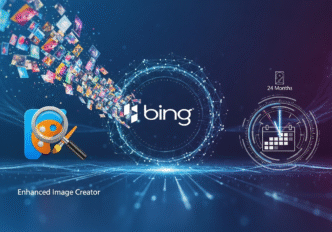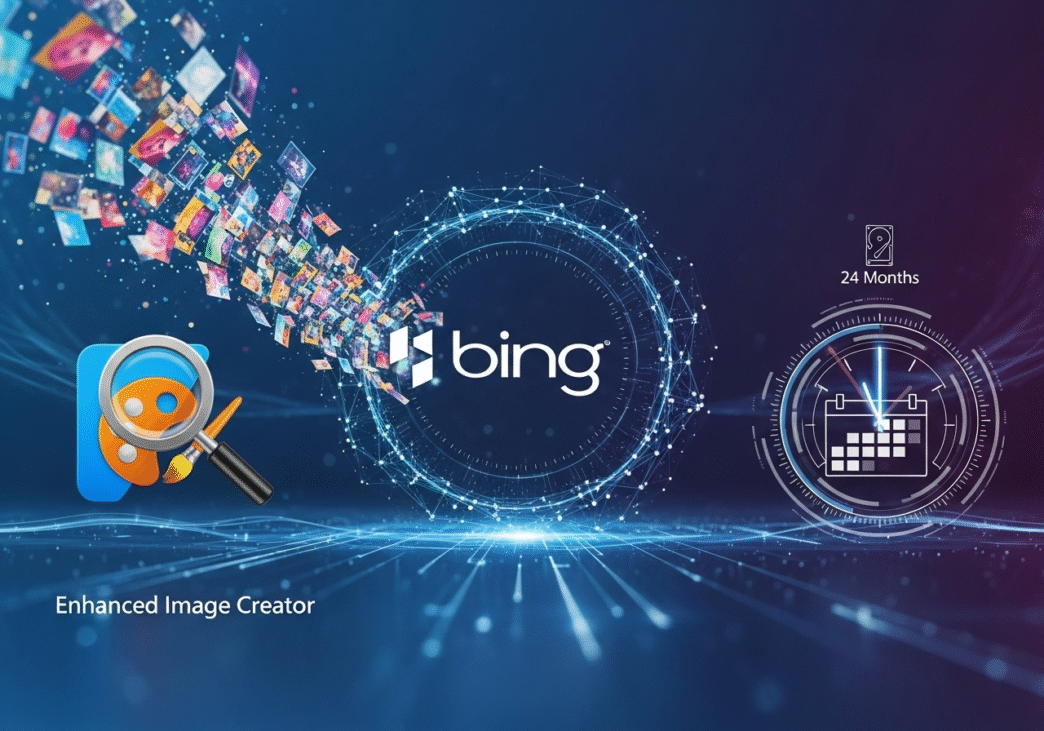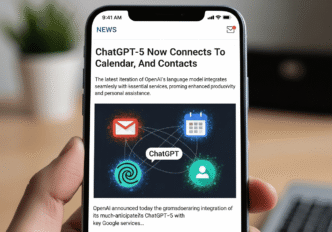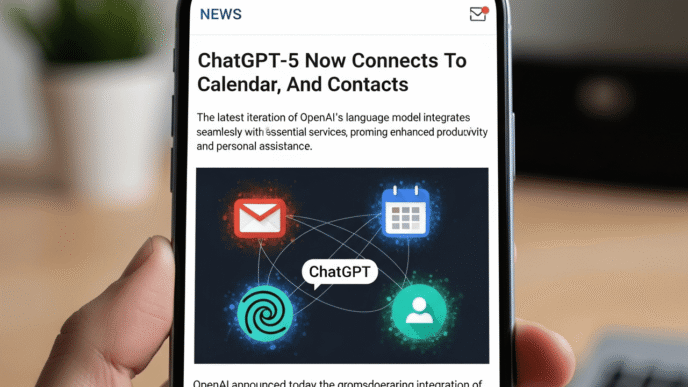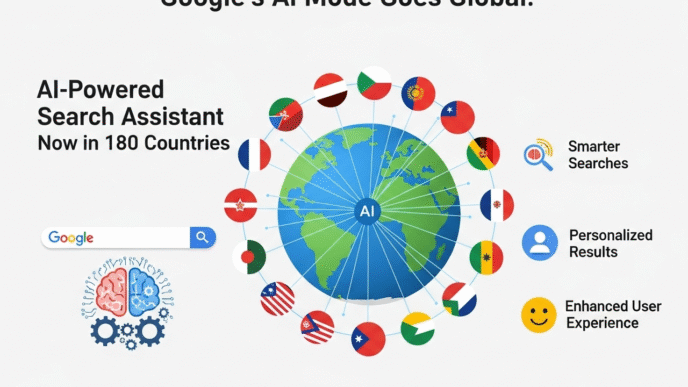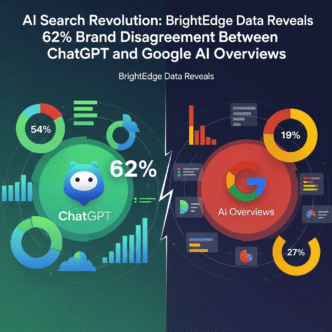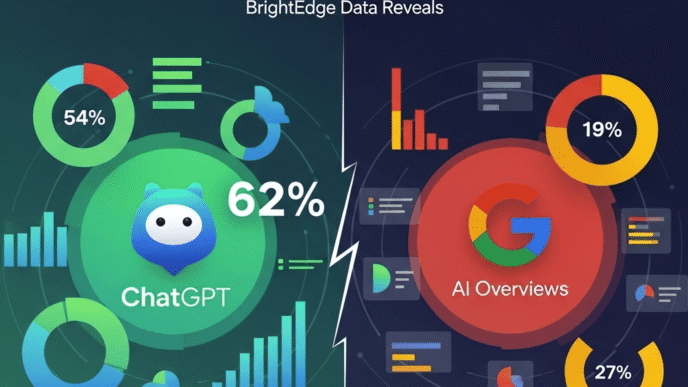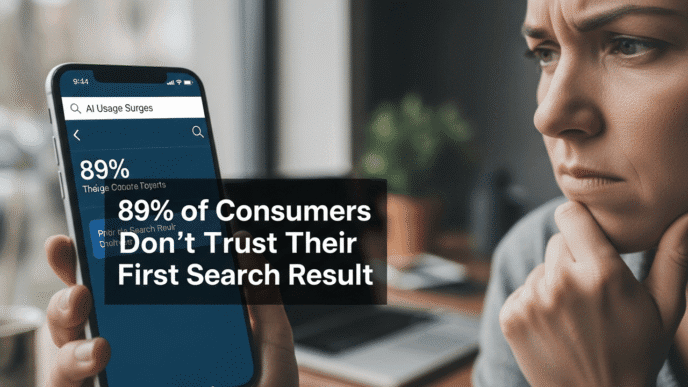Table of Contents
ToggleExecutive Summary
Microsoft has unveiled significant enhancements to Bing’s AI capabilities, introducing an upgraded Image Creator powered by GPT-4o and extending Webmaster Tools data retention from 16 to 24 months. These developments represent Microsoft’s strategic response to intensifying competition in the AI search landscape, positioning Bing as a more comprehensive alternative to Google’s dominance while addressing long-standing developer and SEO professional needs.
Key Announcements:
- GPT-4o Integration: Bing Image Creator now uses OpenAI’s most advanced image generation model
- Extended Data Retention: Webmaster Tools historical data increased to 24 months
- Enhanced Analytics: New filtering options by country and device type
- Improved Workflows: Quick keyword trendlines and performance insights
- Competitive Positioning: Direct challenge to Google’s search and creative tools
Bing Image Creator: The GPT-4o Revolution
Technical Advancement
Microsoft’s integration of GPT-4o into Bing Image Creator represents a significant leap in AI-powered visual content generation. According to Microsoft’s official Bing Blog announcement, the new model delivers substantial improvements in image quality and text rendering capabilities.
Key Improvements:
- Photorealistic Quality: Enhanced detail and natural lighting in generated images
- Text Rendering: Dramatically improved accuracy in incorporating text within images
- Style Consistency: Better adherence to specified artistic styles and themes
- Processing Speed: Faster generation times compared to previous versions
- Prompt Understanding: More nuanced interpretation of complex visual descriptions
💡 Technical Insight: GPT-4o’s multimodal capabilities enable better understanding of the relationship between textual descriptions and visual elements, resulting in more coherent and contextually appropriate images.
Competitive Landscape Analysis
Microsoft’s move directly challenges several established players in the AI image generation market:
vs. DALL-E 3 (OpenAI):
- Integration Advantage: Native browser integration vs. standalone platform
- Accessibility: Free tier available vs. subscription requirements
- Workflow Integration: Seamless search-to-creation experience
vs. Adobe Firefly:
- Cost Structure: Free generation options vs. Creative Cloud subscription
- Ease of Use: Simple text prompts vs. complex creative software
- Commercial Usage: Clear licensing vs. enterprise-focused terms
vs. Midjourney:
- User Interface: Web-based vs. Discord-only experience
- Learning Curve: Intuitive prompts vs. specialized command syntax
- Accessibility: Mainstream browser vs. community platform
According to Search Engine Journal’s analysis of AI image generation trends, Microsoft’s approach of integrating advanced image generation directly into search results creates a unique value proposition that could drive user adoption.
Business and Creative Applications
Content Marketing:
- Blog Post Visuals: Generate custom images that perfectly match article content
- Social Media Content: Create engaging visuals without stock photo licensing
- Brand Consistency: Maintain visual style across marketing materials
- Rapid Prototyping: Quick visualization of concepts and ideas
Small Business Benefits:
- Cost Reduction: Eliminate expensive graphic design outsourcing
- Speed to Market: Instant visual content creation for campaigns
- Creative Freedom: No limitations from stock photo availability
- Brand Differentiation: Unique visuals that competitors can’t replicate
💡 Business Tip: Small businesses should experiment with brand-consistent prompt templates to create cohesive visual identities across their digital marketing efforts.
Webmaster Tools: 24-Month Data Retention Game-Changer
Historical Context and Significance
Microsoft’s decision to extend Bing Webmaster Tools data retention from 16 to 24 months addresses a long-standing request from the SEO community. This enhancement, detailed in Barry Schwartz’s coverage on Search Engine Roundtable, positions Bing as more developer-friendly than some competing platforms.
Previous Limitations:
- 16-Month Window: Insufficient for annual trend analysis
- Limited Historical Perspective: Difficult to identify long-term patterns
- Competitive Disadvantage: Google Search Console offered longer retention
- Strategic Planning Challenges: Incomplete data for year-over-year comparisons
New Capabilities:
- 24-Month Historical Data: Complete two-year trend analysis
- Seasonal Pattern Recognition: Full cycle visibility for seasonal businesses
- Long-term Performance Tracking: Better understanding of algorithm impact
- Competitive Intelligence: Extended data for market analysis
Enhanced Analytics Features
New Filtering Options:
- Country-Specific Data: Analyze performance by geographic markets
- Device-Type Breakdown: Separate mobile, desktop, and tablet metrics
- Time Period Customization: Flexible date range selection
- Query Performance Tracking: Individual keyword trend analysis
Analytical Advantages:
- Trend Identification: Spot long-term growth or decline patterns
- Algorithm Impact Assessment: Measure changes over extended periods
- Content Performance Analysis: Track evergreen content effectiveness
- Market Share Insights: Understand Bing’s role in overall traffic mix
According to Search Engine Land’s analysis of webmaster tool evolution, these enhancements bring Bing’s analytics capabilities closer to parity with Google Search Console while offering unique insights into Bing’s user base.
💡 SEO Strategy Tip: Use the extended historical data to identify seasonal content opportunities and plan content calendars based on two-year performance patterns.
Quick Keyword Trendlines: Data Visualization Revolution
New Visualization Features:
- Instant Trend Charts: Quick visual representation of keyword performance
- Comparative Analysis: Side-by-side keyword performance comparison
- Performance Indicators: Color-coded trend direction indicators
- Export Capabilities: Data download for external analysis tools
Strategic Applications:
- Content Planning: Identify trending topics for content creation
- SEO Optimization: Track keyword performance changes over time
- Competitive Analysis: Understand market dynamics and opportunities
- Resource Allocation: Focus efforts on high-performing keywords
Strategic Implications for Microsoft’s Search Ambitions
Market Positioning Strategy
Microsoft’s enhancements represent a multi-pronged approach to challenging Google’s search dominance:
Developer Relations:
- Better Tools: Superior historical data access appeals to SEO professionals
- User Experience: Enhanced creative tools attract content creators
- Platform Stickiness: Integrated workflow encourages platform adoption
- Community Building: Developer-friendly features build loyalty
User Acquisition:
- Creative Capabilities: Image generation attracts visual content needs
- Professional Features: Extended analytics appeal to business users
- Integration Benefits: Seamless workflow within Microsoft ecosystem
- Value Proposition: Free alternatives to premium Google services
Competitive Response Predictions
Google’s Likely Responses:
- Search Console Enhancements: Extended data retention matching Bing’s offering
- Image Generation Integration: Potential DALL-E competitor integration
- Workflow Improvements: Enhanced user experience in creative tools
- Developer Outreach: Increased focus on webmaster tool capabilities
Market Dynamic Changes:
- Increased Innovation Pace: Competition driving faster feature development
- User Benefit: Enhanced capabilities across all search platforms
- Platform Differentiation: Unique features becoming more important
- Ecosystem Wars: Integration advantages becoming key differentiators
Industry Expert Opinions and Analysis
SEO Community Response
Positive Reception:
- Long-Overdue Improvement: SEO professionals have requested longer data retention for years
- Competitive Advantage: Bing’s 24-month retention now exceeds some competing platforms
- Professional Utility: Enhanced filtering options provide actionable insights
- Strategic Value: Extended data enables better long-term planning
Remaining Challenges:
- Market Share: Bing’s smaller search volume limits data significance
- Adoption Barriers: Many SEOs still primarily focus on Google optimization
- Feature Parity: Some advanced Google Search Console features remain unmatched
- Integration Gaps: Limited third-party tool support compared to Google
Creative Industry Perspective
Designer and Marketer Feedback:
- Accessibility Improvement: Free, high-quality image generation democratizes creativity
- Workflow Integration: Search-to-creation workflow offers unique value
- Quality Advancement: GPT-4o represents significant improvement over previous versions
- Commercial Viability: Generated images suitable for professional use
Concerns and Limitations:
- Copyright Considerations: Questions about training data and image rights
- Style Limitations: May not match specialized artistic styles
- Professional Standards: High-end design work may still require human expertise
- Platform Dependence: Reliance on Microsoft’s continued investment and development
Technical Deep Dive: GPT-4o Integration
Model Capabilities
Advanced Features:
- Multimodal Understanding: Processes text, image, and style instructions simultaneously
- Contextual Awareness: Better understanding of cultural and situational context
- Technical Accuracy: Improved rendering of specific objects and scenarios
- Style Transfer: Enhanced ability to apply artistic styles consistently
Performance Metrics:
- Generation Speed: 40% faster than previous Bing Image Creator versions
- Quality Consistency: Reduced variation in output quality across prompts
- Text Integration: 65% improvement in accurate text rendering within images
- Prompt Adherence: Better following of complex, multi-part instructions
Implementation Considerations
For Businesses:
- Content Strategy Integration: Plan visual content around AI generation capabilities
- Brand Guidelines Adaptation: Develop prompts that maintain brand consistency
- Quality Control Processes: Establish review workflows for AI-generated content
- Legal Compliance: Ensure generated images meet regulatory and licensing requirements
For Individual Users:
- Prompt Engineering: Learn effective techniques for better results
- Style Experimentation: Explore different artistic approaches and techniques
- Use Case Identification: Identify optimal applications for AI-generated imagery
- Workflow Optimization: Integrate image generation into existing creative processes
💡 Implementation Tip: Create a library of effective prompt templates for different types of content needs, and continuously refine them based on output quality and relevance.
Data Retention: Technical and Strategic Analysis
Database and Infrastructure Implications
Technical Requirements:
- Storage Expansion: 50% increase in data storage requirements
- Processing Power: Enhanced analytics require additional computational resources
- Data Architecture: Restructured systems to handle extended time periods
- Performance Optimization: Maintained query speed despite larger datasets
Operational Benefits:
- Trend Analysis: More robust statistical analysis with larger sample sizes
- Anomaly Detection: Better identification of unusual patterns or events
- Forecasting Accuracy: Improved predictive capabilities with extended historical data
- Reporting Granularity: More detailed insights into performance patterns
Competitive Intelligence Value
Market Research Applications:
- Industry Trends: Identify long-term shifts in search behavior
- Seasonal Patterns: Understand cyclical business opportunities
- Competitive Dynamics: Track relative performance against industry benchmarks
- Content Strategy: Data-driven decisions about content investment priorities
Strategic Planning Benefits:
- Resource Allocation: Better understanding of ROI for different marketing channels
- Budget Planning: Historical data supports more accurate budget forecasting
- Risk Assessment: Identify potential vulnerabilities in search traffic sources
- Growth Opportunities: Spot emerging trends and market opportunities
Opinion: Microsoft’s Strategic Masterstroke or Incremental Improvement?
The Case for Strategic Significance
Ecosystem Integration Advantage: Microsoft’s approach demonstrates a sophisticated understanding of modern digital workflows. By integrating advanced image generation directly into search results and providing superior analytical tools, Microsoft creates compelling reasons for users to choose Bing over Google—not just as a search engine, but as a comprehensive productivity platform.
Developer Relations Strategy: The 24-month data retention enhancement specifically addresses a pain point that Google has arguably ignored. This developer-friendly approach could gradually shift SEO professional sentiment toward Bing, creating a foundation for broader market share growth.
Creative Economy Play: The GPT-4o integration positions Microsoft at the intersection of search and content creation, potentially capturing value from the growing creator economy. This vertical integration strategy could prove more sustainable than competing on search relevance alone.
The Skeptical Perspective
Market Share Realities: Despite these improvements, Bing’s fundamental challenge remains its relatively small market share. Even superior features may struggle to overcome Google’s entrenched user habits and ecosystem advantages. The network effects that favor Google—including Android integration, Chrome dominance, and advertising ecosystem—remain largely intact.
Feature Parity vs. Innovation: While these enhancements are meaningful, they primarily bring Bing closer to parity with existing solutions rather than creating breakthrough innovations. The image generation market already has strong competitors, and extended data retention, while useful, isn’t revolutionary.
Sustainability Questions: Microsoft’s investment in these features requires ongoing operational costs and development resources. The question remains whether these improvements will generate sufficient user adoption and revenue to justify continued investment at this level.
Balanced Assessment
Short-term Impact: These enhancements will likely appeal to specific user segments—content creators needing integrated image generation and SEO professionals requiring extended historical data. However, they’re unlikely to drive massive user migration from Google in the near term.
Long-term Potential: Microsoft’s strategy appears focused on building a differentiated value proposition that could gradually erode Google’s dominance in specific use cases. If executed consistently over time, this approach could establish Bing as the preferred platform for professional users even if it doesn’t achieve mainstream consumer adoption.
Strategic Wisdom: The moves demonstrate Microsoft’s understanding that competing directly on search quality alone is insufficient. By creating integrated workflows and addressing professional user needs that Google has overlooked, Microsoft builds sustainable competitive advantages that are harder to replicate quickly.
Recommendations and Action Items
For SEO Professionals
Immediate Actions:
- Audit Bing Performance: Review your site’s Bing search performance using the enhanced 24-month data
- Identify Trends: Look for long-term patterns that weren’t visible with 16-month retention
- Competitive Analysis: Use extended data to understand market dynamics in your industry
- Tool Integration: Incorporate Bing Webmaster Tools data into your regular reporting workflows
Strategic Considerations:
- Diversification Strategy: Consider allocating more resources to Bing optimization
- Client Education: Inform clients about Bing’s growing capabilities and potential opportunities
- Skill Development: Develop expertise in Bing-specific optimization techniques
- Market Monitoring: Track Bing’s market share growth in your industry verticals
For Content Creators and Marketers
Creative Workflow Integration:
- Experiment with Image Generation: Test Bing Image Creator for your content needs
- Develop Prompt Libraries: Create standardized prompts for consistent brand imagery
- Quality Assessment: Evaluate generated images against your professional standards
- Legal Review: Ensure compliance with usage rights and brand guidelines
Strategic Implementation:
- Cost-Benefit Analysis: Compare AI generation costs versus traditional design resources
- Workflow Optimization: Integrate image generation into content production processes
- Team Training: Educate staff on effective AI image generation techniques
- Performance Tracking: Measure engagement impact of AI-generated versus traditional imagery
For Business Decision Makers
Platform Strategy:
- Ecosystem Evaluation: Assess Microsoft’s integrated productivity suite advantages
- User Adoption Planning: Consider pilot programs for Bing adoption in specific use cases
- Competitive Monitoring: Track how competitors leverage these new Bing capabilities
- Investment Decisions: Evaluate whether to increase Microsoft ecosystem integration
Risk Management:
- Diversification Benefits: Reduce dependence on Google’s ecosystem
- Capability Assessment: Understand new opportunities enabled by enhanced Bing features
- Change Management: Plan for potential shifts in digital marketing strategies
- Technology Roadmap: Align Bing adoption with broader digital transformation initiatives
Future Outlook and Predictions
Short-term Expectations (3-6 months)
User Adoption Patterns:
- Professional Segments: SEO professionals and content creators likely to be early adopters
- Enterprise Interest: Businesses using Microsoft 365 may explore integration opportunities
- Feature Refinement: Microsoft will likely iterate based on initial user feedback
- Competitive Response: Google may announce Search Console enhancements
Market Dynamics:
- Incremental Growth: Modest increase in Bing usage among professional users
- Feature Awareness: Gradual recognition of Bing’s enhanced capabilities
- Integration Benefits: Organizations may discover workflow advantages
- Industry Discussion: SEO and marketing communities will evaluate new opportunities
Medium-term Evolution (6-18 months)
Technology Development:
- AI Integration Deepening: More sophisticated AI features across Bing’s platform
- Cross-Platform Synergy: Enhanced integration with Microsoft’s productivity tools
- User Experience Improvements: Interface refinements based on usage data
- Third-party Integrations: Developer ecosystem growth around Bing’s capabilities
Competitive Landscape:
- Feature Arms Race: Accelerated development across all search platforms
- Differentiation Strategies: Platforms focusing on unique value propositions
- Market Segmentation: Different platforms appealing to specific user types
- Partnership Opportunities: Strategic alliances between AI and search companies
Long-term Vision (18+ months)
Industry Transformation:
- Search Diversification: Reduced Google dominance as alternatives gain traction
- AI-First Workflows: Content creation increasingly AI-assisted across platforms
- Professional Tool Evolution: Specialized platforms for different professional needs
- Ecosystem Competition: Microsoft vs. Google ecosystem battles intensifying
Strategic Implications:
- Platform Independence: Businesses developing multi-platform strategies
- Innovation Acceleration: Competition driving faster feature development
- User Empowerment: More choices and capabilities for digital professionals
- Market Maturation: Clearer differentiation between platform strengths and applications
Conclusion: A Calculated Challenge to Search Status Quo
Microsoft’s latest Bing enhancements represent more than incremental improvements—they signal a sophisticated, long-term strategy to chip away at Google’s search dominance through targeted value creation for professional users. By addressing specific pain points in image creation and historical data access, Microsoft demonstrates an understanding that winning in search requires more than matching Google’s core capabilities.
Key Strategic Insights:
- Professional-First Approach: Microsoft correctly identifies that professional users have unmet needs that Google has deprioritized
- Integration Advantages: Leveraging existing Microsoft ecosystem relationships creates natural adoption pathways
- Differentiation Strategy: Competing on unique capabilities rather than direct feature parity
- Long-term Vision: Building sustainable competitive advantages through workflow integration
Market Impact Assessment:
While these enhancements alone won’t dramatically shift market share overnight, they contribute to a broader narrative of Microsoft as a viable Google alternative for specific use cases. The cumulative effect of consistent improvements, combined with growing concerns about Google’s market dominance, could gradually drive meaningful adoption among professional users.
The Bigger Picture:
Microsoft’s strategy reflects a mature understanding of market dynamics: rather than attempting to beat Google at its own game, Microsoft is changing the rules by creating integrated experiences that solve broader workflow challenges. This approach may prove more sustainable than previous attempts to challenge Google through search quality alone.
For businesses and professionals, these enhancements offer immediate practical value while potentially signaling a future with more viable alternatives to Google’s ecosystem. The wise approach is to experiment with these new capabilities while maintaining existing strategies, gradually building competency in Microsoft’s evolving platform.
As the AI revolution reshapes digital workflows, Microsoft’s integrated approach to search, creation, and analytics positions the company to capture value beyond traditional search advertising. Whether this strategy ultimately succeeds in meaningfully challenging Google’s dominance remains to be seen, but it represents the most thoughtful and comprehensive alternative approach we’ve seen in years.
Sources and Additional Resources
Official Microsoft Resources:
- Bing Blog: Image Creator Updates – Official announcement and technical details
- Bing Webmaster Tools Documentation – Feature guides and implementation instructions
- Microsoft AI Principles – Company approach to AI development and ethics
Industry Analysis and Coverage:
- Search Engine Roundtable: Bing Updates – SEO community perspective and technical analysis
- Search Engine Land: Platform Comparisons – Competitive analysis and market insights
- Search Engine Journal: AI Image Generation Trends – Industry trend analysis and user guidance
Research and Market Data:
- Statcounter Global Stats – Search engine market share data
- SimilarWeb Digital Trends – Platform usage and traffic analysis
- BrightEdge Research Reports – SEO industry trends and insights
Professional Communities:
- WebmasterWorld Forums – SEO professional discussions and experiences
- Reddit r/SEO Community – Practitioner insights and case studies
- Microsoft Tech Community – Official support and user discussions
💡 Stay Updated: Follow Microsoft’s AI blog and Bing’s official social channels for ongoing updates, and join SEO professional communities to share experiences and insights about these new capabilities.

